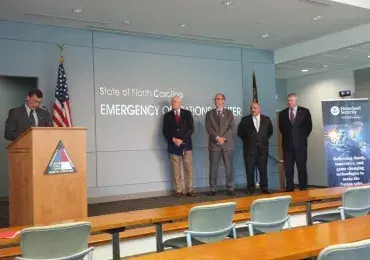For Immediate Release
DHS Science & Technology Press Office
Contact: John Verrico, (202) 254-2385
S&T Provides $20M in Funding to Address Coastal Challenges
 The University of North Carolina at Chapel Hill officially launched today a new Coastal Resilience Center of Excellence (CRC) on June 23 which was made possible through a five-year, $20 million grant from S&T. The CRC initiative led by UNC-Chapel Hill will include collaboration with more than a dozen partner universities to address the unique challenges facing communities across the U.S. that are vulnerable to coastal hazards.
The University of North Carolina at Chapel Hill officially launched today a new Coastal Resilience Center of Excellence (CRC) on June 23 which was made possible through a five-year, $20 million grant from S&T. The CRC initiative led by UNC-Chapel Hill will include collaboration with more than a dozen partner universities to address the unique challenges facing communities across the U.S. that are vulnerable to coastal hazards.
“Our nation’s university system is a constant source of innovation and fresh ideas where many of the best and brightest minds reside,” said Dr. Robert Griffin, DHS Deputy Under Secretary for Science and Technology, who also spoke at the CRC launch press conference. “DHS Centers of Excellence are vital partners in our mission to develop solutions to some of the most complex and dangerous natural disasters that we face.”
The CRC, which will receive an initial $3 million grant for its first operating year, is charged with helping to conduct research and education that directly addresses key challenges associated with growing coastal vulnerability. Examples include:
- Develop more accurate storm surge models and timely delivery of accurate predictions of storm surge prior to storm land-fall.
- Assist the Federal Emergency Management Agency (FEMA), states, and local governments in the development of better predictions of coastal hazards and pre-disaster plans.
- Improve understanding about why individuals choose to (or not to) implement risk-reduction measures at the household level and what risk-reduction measures they employ.
- Improve the ability to communicate risk to multiple audiences and take action based on that understanding.
- Educate the next generation of students that will become hazards researchers and practitioners, emphasizing the development of certificate and degree programs in minority-serving educational institutions.
Critical to this effort is collaboration and partnership.
 “We have partners that range from the west coast to the east coast, from the Gulf to the Great Lakes,” said Dr. Rick Luettich, CRC Principal Investigator, UNC-Chapel Hill. “This is like a hub here in North Carolina, and the spokes go out from here to coastal locations across the U.S.”
“We have partners that range from the west coast to the east coast, from the Gulf to the Great Lakes,” said Dr. Rick Luettich, CRC Principal Investigator, UNC-Chapel Hill. “This is like a hub here in North Carolina, and the spokes go out from here to coastal locations across the U.S.”
Another critical goal of the CRC is educating young scholars and professionals working on the ever changing subject of coastal hazards.
“The research that we’re getting and some of the knowledge that we’re developing is translating itself into undergraduate and graduate courses,” said Dr. Gavin Smith, CRC Director, UNC-Chapel Hill. “We are educating another generation of students and future scholars that come through the program, preparing them for various careers in the field.”
The launch of the CRC builds upon the previous work of the DHS Coastal Hazards Center, co-led by UNC and Jackson State University, which started in 2008. The center’s work has informed the U.S. Coast Guard and FEMA on operational decisions during natural disasters, including Hurricane Sandy, by developing a storm surge and flood model that helped indicate precisely where to stage resources ahead of the storm.
